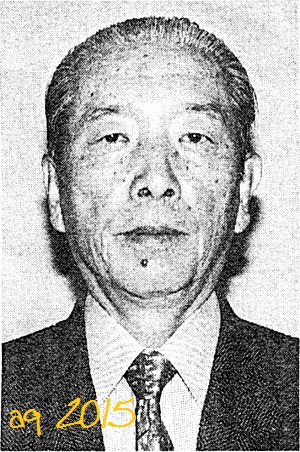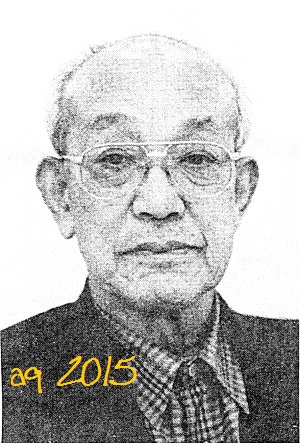Recently I talked about the Chatan Yara Kusanku currently demonstrated at sports tournaments and that it is not the original kata. In a 1999 article the arbitrary modification of Chatan Yara Kūsankū and kata were adressed by two old boys (top officials) of the JKF.
Arakawa Tooru: Are kata being arbitrarily reconfigured?
“Chatan Yara Kūsankū” these days is commonly seen among the superior prize-winners at the WKF world championships, the All-Japan tournament, the National Athletic Meet, the inter-high school competitions and so on. Yet, almost all of these “Chatan Yara Kūsankū” are modified copies of the original form. Although it is not a standardized shitei-kata but a freestyle-kata (tokui), these days it seems to be considered “okay” to arbitrarily modify kata. I have inquired about this issue with Arakawa Tooru, senior of JKF Wadōkai and head of the secretariat of the Zen Nihon Karate-dō Renmei (incorporated foundation).
“If there is consensus, the remodeling of kata will not stop.”
Interviewer: –Under the current rules, the modification of freestyle-kata (tokui-gata) gained official approval, isn’t it?
Arakawa: Even in the previous general assembly of the WKF (World Karate Federation) the topic was raised if it wouldn’t be good to create freestyle-kata (tokui-gata), which was fiercely opposed by Japan. It’s true: Over the course of their transmission many kata were changed little by little based on a varying understanding within the flow of time. However, I think that kata which were excessively and creatively manipulated must not receive approval.
Interviewer: — Certainly, even the current standardized shitei-gata are different from those kata originally created by our predecessors.

Arakawa Tooru, senior of JKF Wadōkai and head of the secretariat of the Zen Nihon Karate-dō Renmei (incorporated foundation).
Arakawa: That’s right. Moreover, kata have changed en route over decades of being handed down even within one and the same style (ryūha). However, although they have changed over the decades they found international approval among the experts. Alternatively, an entire organization (kaiha) would make changes by saying “If we change individual parts of this kata, it will be an improvement!” In other words, if it was considered beneficial by consensus of a majority, or by a general trend, kata were changed. This doesn’t mean that individuals are authorized to create their own modifications in order to obtain higher scores in tournaments.
Interviewer: — In group-kata (dantai-kata) and the like the thing called awaseru (synchronized movements) has become an indispensable constituent. This being so, it appears likely that the kata will also not be in their proper condition anymore …
Arakawa: I think the synchronized movements as a means to externally adjust the relation between the players in group-kata (dantai-kata) have no right to exist outside of competition.
“As an Olympic event, uniformity becomes an imminent necessity.”
Interviewer: — In Japan the movements of the current standardized shitei-kata have been codified. But as abroad only the names of the shitei-kata seems to have been specified I have often heard that kata, even though bearing the same name, are performed differently …
Arakawa: Certainly in the WKF only the names and not the techniques of the kata are specified. But since this causes confusion, I think that at least in the future they need to adopt the method analogous to Japan.
Interviewer: — Moreover, a real problem is if karate will be selected as an official event of the Olympic Games. Under the current circumstances, with rules not providing for uniformity, the question remains whether karate could be implemented as a competition sport at the Olympic Games at all.
Arakawa: Yes. This issue is not limited to kata, but the current kumite rules would also be inevitably jumbled. In this sense, as regards the rules it can be said that the present time can be understood as a transition period. However, in the future, and even right now, persons engaged in the karate circles rack their intelligent brains as they must not and should not create rules only for the sake of allowing third parties [=laymen] to spectate at and to understand karate. To put it the other way around: The present time, with the participation in the Olympics perceived as the just cause, is not a good opportunity for implementing measures to unify the rules.
Interviewer: –In this sense, the “unification of the rules” seems to already be a tentative working title. Thank you for taking the time today.
Tsujikawa Yoshiaki: “We want to bequeath the traditional kata to future generations …”
- Tsujikawa Yoshiaki was born February 10, 1916 in Kōbe City in Hyōgo Prefecture. Since around 1935 he entered the way of karate studying under his venerated master Mabuni Kenwa, founder of Shitō-ryū. At the time of the interview he acted as an advisor of the Zen Nihon Karate-dō Renmei (JKF) and held the important office of an “elder statesman” of the Zen Nihon Karate-dō Renmei Shitōkai (JKF Shitōkai).
Currently, the competition rules used by the Zen Nihon Karate-dō Renmei (JKF) and other associations clearly distinguish kata and kumite. Around 1950, however, there was no clarity. In the early form of kata competition of those days, good performance results were rarely achieved. The modus also did not abet kumite. It was something similar to what is today referred to as “mixed-rules”.
Nowadays it can be said that kata-players concern themselves with kata, and kumite‑players concern themselves with kumite. By this development it can be said that the competition techniques of both these methods improved to the better. However, Tsujikawa Yoshiaki sensei, who was involved in the preparation of the JKF competition rules, describes competition with special reference to kata as follows.
“The more karate transforms into a sport which excessively emphasizes the aggrandizement of exterior appearance, the more it eclipses the original, inherent quality of karate. For the dissemination of karate-dō, competition karate was also necessary to a certain extent. But it is absolutely embarrassing to forget the original thing called budō karate.

Tsujikawa Yoshiaki, advisor of the Zen Nihon Karate-dō Renmei (JKF), “elder statesman” of the Zen Nihon Karate-dō Renmei Shitōkai (JKF Shitōkai)
At the present time, among those players solely involved in competition karate there are those who obviously execute the visual outer form of it only and without understanding its meaning, importance, scope, and value. In addition, among the young sensei who are referees there is also a portion who make decisions without knowing the actual meaning. In addition, the negative effect has occurred that high scores are being issued for spruced up and sappy-athletic techniques. The mainstream has become something that seems to be intended to be spectated at by inexpert, laymen eyes. Since by this development I worry about the very future of karate, I think it is at all costs necessary to rectify these developments. At the present time in competition karate no points are awarded for the performance of budō karate. Because the Zen Nihon Karate-dō Renmei (JKF) is an organization that carries competition karate to extremes it is unable to address this issue. I think that from now on there is the necessity to seriously consider what to do about this in karate. Within the ryūha there is a huge indignation about this issue so much that even a movement emerged to once more begin from the very start. Within the Shitōkai there is to some extent the idea to separate budō-like karate from competition-like karate and to start providing respective education to raise the level of proficiency. At the same time, rather than the current complete devotion to technical aspects only, the mental aspects also need to be re-examined. We must place greater importance to the mental tempering, or forging.
Karate has achieved its current popularity and development by the “two wheels” of 1) karate in its capacity as a budō and 2) karate in its capacity as a competition sport. The more the transformation of karate into a sport advances, the more its tinge as a budō becomes diluted. If the budō elements are pushed over the edge of the cliff, then karate as a competition is no longer a budō.
This is an extremely serious issue which each one of us – as karate people – must always keep in mind.”
To be continued …
© 2015 – 2016, Andreas Quast. All rights reserved.
